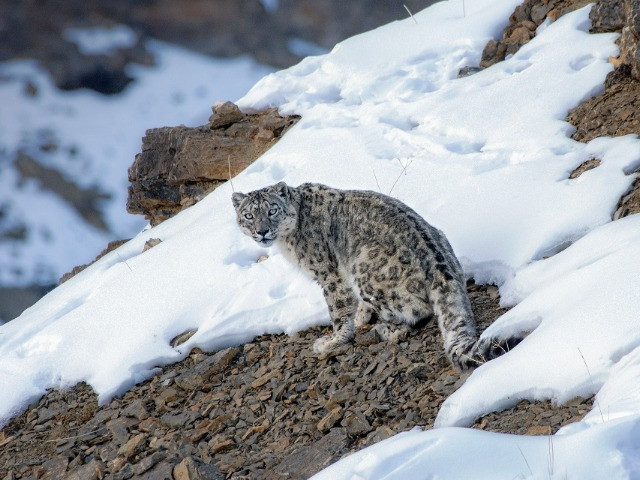In August 2021, along with a friend, I headed out to Ulley, Ladakh to shoot for a 360° stereoscopic documentary meant to be experienced on a VR headset. In this remote Transhimalayan village, at an elevation of 14,000ft, a community of six families coexists with an elusive animal as grey as the mountains—the Snow Leopard. The film is told through the eyes of Morup Namgail, a 26-year-old filmmaker from the village who is also an expert Snow Leopard tracker. It immerses the viewer in the journey of filming and photographing the big cat using camera traps, thereby narrating the complex tale of human-animal co-existence and the issues that threaten the region.
A 20-day schedule had us dedicating 15 days to camera trapping. There were intensive discussions around the possible movements of the cat, the potential battery life of the camera, the flash and PIR sensor, and the countless possibilities for technical errors once the camera trap is deployed in the field.
We were essentially trying to find a needle in a vast, infinite haystack, and with the weather not helping, it just became that much more difficult. Within their habitat, Snow Leopards like steep, rocky areas with few plants—regions that scientists refer to as alpine and subalpine zones. During the warmer summer months, they occupy the subalpine zones to escape the harsh sunlight on the summit and for the abundance of prey. This makes it extremely difficult to spot them during the summer period. It was a task we had undertaken to try and get a closer perspective of the cat, in its natural habitat, outside human presence.
After a 6-hour hike, adequate testing of the equipment and cups and cups of hot chamomile tea, we successfully placed the cameras on location and returned with just our hopes and internal dilemmas. It was important to make sure our systems camouflaged well with the terrain, with minimum intrusion from human elements.
Until now, various factors were in our control, and we had made the best use of them as possible, but on the way back, all I could think of was the unlikely marriage of our preparation with the odds of the big cat choosing the route where we had placed the cameras. Eventually, we got on with the shoot.
During our time there, we hiked to the trap location seven times to make sure the flash battery did not lose its charge. We had not carried extra batteries for the flash, which had us climbing more than we had anticipated. Each time, the camera would be operating fine, but the flash would have lost its charge every five days. Added to this, the disappointment of finding zero triggers fired on the camera weighed us down even more. But, I had made up my mind to not go back home without making a Snow Leopard image.
Fourteen nights had passed. Before our last hike of the schedule, Divy asked me, “What do you think?” I knew what he was talking about, we only had one thought on our minds. “Honestly, I have no idea, no clue at all!” I replied as I sipped my morning coffee. There was a certain silence in the air that morning, and I clearly remember that we spoke very little as we climbed. I am not sure if we were just mentally and physically exhausted or if all of us were busy writing our own stories and enacting the different possible scenarios in our heads.
You may also like to read
Once we reached the location, as usual, the first thing we did was to sip on a cup of hot chamomile tea. It tastes the best at an elevation of 14,800ft, I realised after coming back home. The moment of truth was upon us. The frequency of imagined scenarios multiplied in the final 100–150 steps to the camera trap. This time around, the flash battery was showing two points, indicating that it had not been used as much, leading us to believe that there had been little movement of fauna in front of the camera. I collected all the wires and the PIR sensor, put them in the casing, and headed back to a less-steep location, where I could check the camera comfortably. The first animal caught on camera was a pika, a rodent that is a resident of the higher altitudes.
As I scrolled through the images, I saw a large mammal, whitish-grey in colour, occupying the majority of the frame. I stopped for a closer look. It was a Snow Leopard! The delirious joy that filled every fibre of my being, the absolute madness of creating an image of the elusive feline against all odds—this was my answer to myself for why I do what I do. An unforgettable feeling, an experience that I will be surely recreating in the coming years (with better preparation and better timing) because, although I have made an image of a Snow Leopard, I have not seen one in person.
Snow Leopards are built to survive and live in the harshest environments. Yet, humans have created an uncertain future for these cats. Among many, habitat loss and climate change are the major threats that these big cats face today—impacts resulting in a loss of up to 30 per cent of their habitat in the Himalayan region alone.
Despite a range of over 2 million kilometres, scientists estimate that there may only be between 3920 to 6390 Snow Leopards left in the wild. The entire premise of conservation rests on people changing their lives in ways both great and small to sustain these precious habitats.










